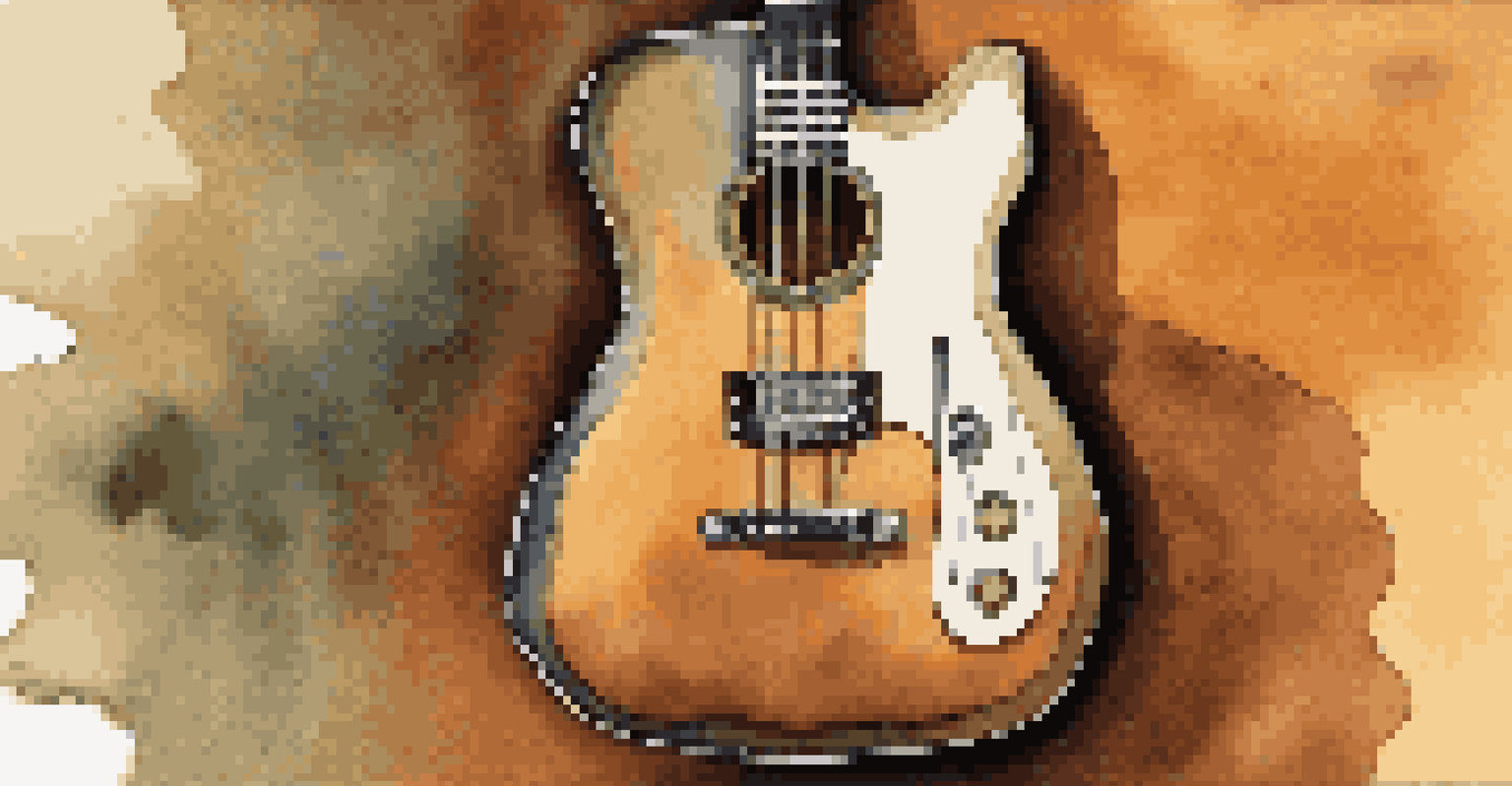Acoustic vs. Electric: The Art of Music Arrangement

Understanding Acoustic and Electric Instruments
Acoustic and electric instruments each have unique characteristics that shape their sound. Acoustic instruments, like guitars and pianos, produce sound naturally through vibrations. In contrast, electric instruments rely on electronic amplification, which can lead to a broader range of sounds and effects.
Music can change the world because it can change people.
The choice between acoustic and electric can significantly influence a song's mood and style. For instance, an acoustic guitar often evokes a warm, intimate feel, perfect for folk or ballads. On the other hand, an electric guitar can create powerful, dynamic soundscapes, often found in rock or pop music.
Understanding these differences is crucial for musicians and arrangers alike. Each type of instrument brings its own flavor to a piece, impacting everything from arrangement to performance. Choosing the right one can elevate a song to new heights.
The Role of Arrangement in Music Creation
Music arrangement is the art of organizing a song's structure and instrumentation. This process transforms a simple melody into a full composition, adding depth and texture. Whether using acoustic or electric instruments, a well-thought-out arrangement can make all the difference.

Consider the arrangement of a song as a roadmap; it guides the listener through various emotional landscapes. By carefully layering sounds and choosing instruments, arrangers can highlight specific sections, creating moments of tension and release. This approach ensures that the listener remains engaged throughout the piece.
Acoustic vs. Electric Sounds
Understanding the distinct characteristics of acoustic and electric instruments is essential for shaping a song's mood and style.
In essence, a good arrangement tells a story. It can evoke emotions, create imagery, and even transport listeners to different places. Whether it’s the soft strumming of an acoustic guitar or the electrifying riffs of an electric one, the arrangement plays a pivotal role in conveying the intended message.
Creating Contrasts with Acoustic and Electric Sounds
One effective technique in music arrangement is creating contrasts between acoustic and electric sounds. This can be achieved by alternating between instruments or layering them in a way that highlights their differences. For example, a soft acoustic guitar riff can serve as a backdrop for a soaring electric guitar solo.
The two most important things when it comes to music are the emotional impact and the arrangement.
These contrasts help to define sections within a song, maintaining listener interest and adding dynamic range. They can also emphasize the emotional shifts in lyrics or melodies, making them more impactful. By thoughtfully juxtaposing sounds, musicians can create a richer audio tapestry.
Using both acoustic and electric instruments allows for a versatile approach to arrangement. This blend can cater to a wide audience, appealing to fans of both styles. Ultimately, it’s about finding the right balance and ensuring each element complements the other.
The Emotional Impact of Acoustic vs. Electric Arrangements
The emotional resonance of music often hinges on the arrangement style. Acoustic arrangements tend to feel more personal and raw, drawing listeners into an intimate space. Think of a singer-songwriter performance; the simplicity of the acoustic guitar paired with heartfelt lyrics creates a strong emotional connection.
In contrast, electric arrangements often convey energy and excitement. The use of effects like distortion, reverb, or delay can evoke feelings of power and urgency. This makes electric arrangements ideal for genres that thrive on high energy, such as rock or electronic music.
The Power of Arrangement
A well-crafted music arrangement not only organizes a song's structure but also enhances emotional engagement with the listener.
Understanding these emotional impacts can guide musicians in their arrangement choices. By aligning the arrangement style with the message of the song, artists can enhance the listener's experience. This thoughtful approach can make a significant difference in how music is perceived and felt.
Technical Considerations: Mixing Acoustic and Electric Sounds
When arranging music with both acoustic and electric instruments, technical considerations come into play. Mixing these sounds effectively requires an understanding of frequencies, dynamics, and spatial placement. Each instrument occupies a different sonic space, and the goal is to create a cohesive blend.
For instance, electric guitars often have a prominent mid-range presence, which can overshadow acoustic sounds if not balanced correctly. Using equalization techniques can help carve out space for each element, ensuring clarity and preventing muddiness. This allows the listener to appreciate the nuances of both instrument types.
Additionally, effects processing can enhance the overall sound. Reverb can create a sense of depth, while compression can help control dynamics. By mastering these technical aspects, musicians can achieve a polished final product that showcases the strengths of both acoustic and electric arrangements.
Arranging for Different Genres: Acoustic vs. Electric
Different musical genres often favor one type of arrangement over the other. For example, folk and country music typically lean towards acoustic arrangements, highlighting storytelling and lyrical depth. The gentle strumming of an acoustic guitar often serves as the backbone for these genres, creating a warm and inviting atmosphere.
In contrast, genres like rock, pop, and electronic music frequently utilize electric arrangements to drive energy and rhythm. The electrifying sound of distorted guitars or synthesized beats captures the audience's attention and keeps them engaged. This distinction showcases how genre influences arrangement choices.
Mixing for Cohesion
Effectively blending acoustic and electric sounds requires technical skill to ensure clarity and balance in the overall music production.
However, blending genres can lead to innovative arrangements. Artists are increasingly experimenting with combining acoustic and electric elements, creating unique sound experiences. This cross-genre experimentation not only broadens musical horizons but also appeals to diverse audiences.
Conclusion: The Artistry of Acoustic and Electric Arrangements
The choice between acoustic and electric arrangements is not merely a technical decision; it’s an artistic one. Each instrument brings its own voice to a composition, shaping the listener’s experience. Recognizing the strengths and emotional impacts of both styles can elevate music to new artistic heights.
As musicians continue to explore the possibilities of blending acoustic and electric sounds, the potential for creativity expands. This fusion allows for innovative arrangements that resonate with a wide range of listeners. Ultimately, it’s about crafting a sonic journey that captivates and connects.

In the end, whether you gravitate towards the warmth of acoustic or the electrifying energy of electric, the art of music arrangement is a beautiful exploration. Embracing both styles can open doors to endless musical possibilities, enriching the world of music for everyone.